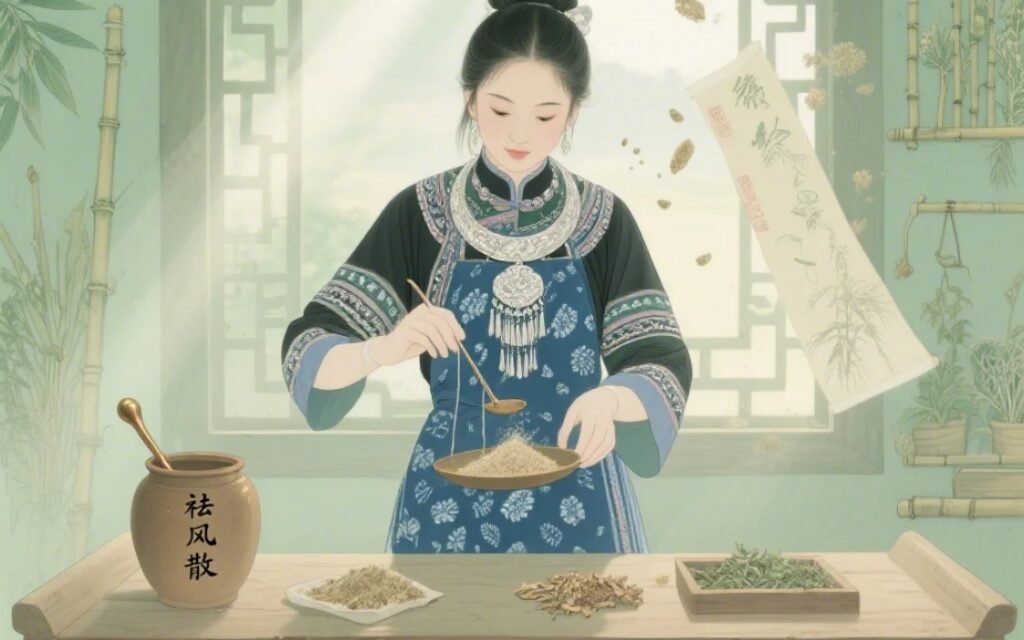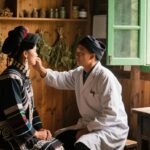Xiutiaofang (Jaundice)
[Overview]
In Miao medicine, jaundice is referred to as Xiutiaofang, also known as Xingfang or Qiuxingfang. It is caused by the invasion of damp-heat pathogens, dietary irregularities, or excessive fatigue. The main pathogenic factors involve either external invasion or internal generation of dampness, which may manifest as either damp-heat or cold-damp patterns. The pathogenesis involves obstruction of the middle burner by dampness, leading to disrupted qi flow, impaired liver and gallbladder function, and abnormal bile flow that spills outward into the skin, resulting in the hallmark symptoms of yellowing of the skin, eyes, and urine.
In Traditional Chinese Medicine (TCM), jaundice mainly results from the liver’s failure to regulate qi, causing bile to overflow. It is characterized by yellow skin, yellow sclera, and yellow urine, with eye yellowing being the most prominent sign. The condition involves the liver and gallbladder and may present as either yang jaundice or yin jaundice. Yang jaundice is caused by the accumulation of damp-heat in the middle burner that steams the liver and gallbladder, manifesting in bright orange discoloration, rapid onset, short duration, yellow greasy tongue coating, and a wiry rapid pulse. Severe cases present with golden-yellow discoloration, confusion, skin eruptions, and bleeding—termed severe yang jaundice. Yin jaundice is caused by cold-dampness resulting from overconsumption of raw or cold foods or excessive fatigue. It manifests in a dull smoky-yellow discoloration, gradual onset, long disease course, poor appetite, fatigue, pale tongue, and a slow pulse.
In Western medicine, jaundice caused by hepatocellular injury, biliary obstruction, hemolysis, acute or chronic hepatitis, cirrhosis, cholecystitis, cholelithiasis, leptospirosis, or certain digestive system tumors may be treated with reference to this condition.
[Hu Hou Ji Peng · Miao Medicine Disease Classification]
Xiutiaofang is considered a minor disorder and is classified into two subtypes: heat-channel jaundice and cold-channel jaundice.
[Ai Jiang Duo · Causes]
Miao medicine attributes disease etiology to both internal injuries and external factors. Internal factors include congenital deficiencies, emotional disturbances, sexual excess, overwork, and dietary imbalances. External factors include damp-heat toxins and physical trauma. Among these, external damp-heat, poor diet, and excessive fatigue are closely associated with the onset of Xiutiaofang.
[Geng Duo Meng · Pathogenesis]
The disease arises from external damp-heat pathogens accumulating in the middle burner, impairing the flow of qi and damaging the spleen and stomach. The steaming effect of damp-heat on the liver and gallbladder impairs their function, causing bile to overflow and leak into the skin. Excessive intake of alcohol, greasy or rich foods, or unhygienic food damages the spleen and stomach, producing phlegm and transforming into heat. The damp-heat then causes bile to leak out, leading to Xiutiaofang. Cold foods, irregular meals, or extreme fatigue lead to internal cold-dampness, which obstructs the middle burner and impairs the liver and gallbladder, causing bile to leak and discolor the skin. Depending on the balance of spleen and stomach yin-yang, dampness may transform into heat or cold, thus distinguishing between heat-channel and cold-channel jaundice.

[Diagnostic Essentials]
Diagnostic Criteria
The main signs include yellow skin, yellow eyes, and yellow urine, with eye yellowing being most distinct.
Accompanying symptoms include abdominal distension, poor appetite, nausea, hypochondriac pain, and heaviness of limbs.
History of exposure to damp-heat, dietary irregularities, overwork, or hypochondriac pain.
Relevant Examinations
Total serum bilirubin levels reflect the severity of jaundice. Conjugated and unconjugated bilirubin help differentiate types. Urinary urobilinogen and bilirubin are also useful for diagnosis.
[Differential Diagnosis]
Jiang Bin Wo (Consumptive Disease)
Though the causes may be similar, the manifestations differ. Xiutiaofang is associated with damp-heat invasion, dietary irregularities, and fatigue after illness. Its pathogenesis involves damp-heat in the spleen leading to liver dysfunction and bile overflow, with yellow skin, eyes, and urine as the main signs. Jiang Bin Wo is a chronic condition caused by overwork or constitutional weakness, which may present with skin yellowing in later stages. Its mechanism involves spleen deficiency leading to poor blood and qi production, or chronic blood deficiency. It features dull, lusterless yellowing of the skin without yellowing of the eyes or urine and is often accompanied by dizziness, tinnitus, palpitations, insomnia, night sweats, and fatigue.
[Syndrome Differentiation and Treatment]
1. Heat-Channel Jaundice
Meng Li Duo (Symptoms): Yellow skin and eyes, yellow urine, fever, dry mouth, bitter taste, nausea, chest tightness, hypochondriac pain, and constipation.
Xing Leng (Channel Type): Heat-channel heat disorder.
Jia He Meng (Treatment Principle): Clear heat and eliminate dampness, relieve jaundice.
Ou Duo Xi Jia · Gang Ou (Prescription and Explanation):
Fang feng (Saposhnikovia root, sao yang gu) 15g
Yin chen (Virgate wormwood, wo fan) 10g
Long dan cao (Chinese gentian root, jia jia shan) 8g
Zi (Unidentified herb, zhen lu) 6g
Ci sang (Spiny mulberry twig, na) 10g
Da huang (Rhubarb root, wo hui qiu) 10g
Functions of herbs:
Fang feng (sao yang gu): Slightly warm, acrid and sweet, warms the middle, dispels cold, moves qi, relieves pain, and detoxifies.
Yin chen (wo fan): Cold, bitter, clears heat, promotes bile flow, and resolves jaundice.
Long dan cao (jia jia shan): Cold and bitter, clears damp-heat from the liver and gallbladder, drains fire, detoxifies.
Zi (zhen lu): Cold and bitter, clears damp-heat and fire toxins.
Ci sang (na): Cold and bitter-sweet, clears damp-heat.
Da huang (wo hui qiu): Cold and bitter, purges fire, cools the blood, clears heat, and eliminates toxins.

These herbs work synergistically to clear heat, drain dampness, detoxify, and relieve jaundice.
2. Cold-Channel Jaundice
Meng Li Duo (Symptoms): Yellow skin and eyes with a dull hue, poor appetite, shortness of breath, fatigue, and loose stools.
Xing Leng (Channel Type): Cold-channel cold disorder.
Jia He Meng (Treatment Principle): Drain dampness, harmonize the stomach, relieve jaundice.
Ou Duo Xi Jia · Wang Ou (Prescription and Explanation):
Diao yu gan (Fishing rod herb, dou lun lei) 10g
Bai shao (White peony root, bai shao) 8g
Di gu pi (Lycium root bark, dou bo) 15g
Yin xing cao (Yin walking herb, jia jia shou) 10g
Mi hou tao gen (Kiwi root, ga jiong zhen jie meng) 20g
Dong kui zi (Cluster mallow seed, wo ta xin) 10g
Functions of herbs:
Diao yu gan (dou lun lei): Cold and bitter, clears heat, detoxifies, drains dampness, disperses blood stasis.
Bai shao (bai shao): Cold and bitter, soothes the liver.
Di gu pi (dou bo): Cold and bitter, nourishes yin, clears liver heat.
Yin xing cao (jia jia shou): Cold, bitter and acrid, clears heat, drains dampness, relieves jaundice, stops pain, and dispels wind.
Mi hou tao gen (zhen jie meng): Cold, sour and sweet, nourishes yin and detoxifies.
Dong kui zi (wo ta xin): Cold and bitter, detoxifies, reduces jaundice, promotes urination, and clears heat.
[Prevention and Care]
Avoid cold exposure and maintain appropriate temperature.
Regulate diet and avoid alcohol and smoking. Consume nutritious, easily digestible food that does not harm the spleen and stomach.
Moderate lifestyle, balance work and rest, regulate emotions, avoid excessive worry, and engage in light exercise such as Tai Chi or walking.
[Commentary]
In Miao medicine, the spleen and stomach belong to the tu jie du jia system, responsible for absorption and digestion. Great importance is placed on this function, which aligns with the TCM view that “the spleen is the postnatal root of life, the source of qi and blood generation.” The key pathogenesis of jaundice is the injury to spleen and stomach due to either damp-heat invasion or internal strain, leading to impaired transformation, endogenous damp-heat, and steaming or obstruction of the liver and gallbladder, causing bile overflow and skin discoloration. The (used in traditional contexts) focuses on clearing heat, eliminating dampness, relieving jaundice, and strengthening the spleen and harmonizing the stomach.


Leave a Reply